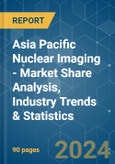The Asia Pacific Nuclear Imaging Market size is estimated at USD 1.52 billion in 2024, and is expected to reach USD 1.88 billion by 2029, growing at a CAGR of 4.23% during the forecast period (2024-2029).
The factors that are propelling the growth of the market include technological advancements, increasing diagnostic applications in various diseases, such as cancer and cardiovascular diseases, and the growing burden of these chronic diseases.
Over recent years, scientists, researchers, and technologists have been able to bring systems in clinical practice, in which two or even more than two standalone diagnostic imaging modalities are combined. Some of those multimodality imaging systems include PET/CT, SPECT/CT, PET/MRI, and PET/SPECT/CT. The shift from standalone to hybrid modalities have improved the applications of these devices in recent times.
Moreover, the rise in the prevalence of cancer and cardiac ailments is one of the primary drivers for the market. Nuclear medicine is hugely capable of treating cancer and cardiac diseases. Asia Pacific region has the highest populous countries like China and India, which in turn contribute to a large aging population. There is also a higher disease incidence in this region increases the demand for advanced technologies like nuclear imaging. There is a large investment on the healthcare setup and medical research making these facilities accessible. The per capita income is increasing in these countries making such technologies more affordable.
As per a 2019 report by Prabha Desikan et al, published in Circulation: Cardiovascular Quality and Outcomes, CVDs are the leading cause of mortality in India. This epidemiological transition is large because of the increase in the prevalence of CVDs and CVD risk factors in India.
Gamma cameras and positron emission tomography scanners are the major imaging devices used in cardiac procedures. SPECT imaging has been the mainstream modality for nuclear cardiology procedures performed worldwide.
Therefore the increasing prevalence of cardiovascular diseases is found contributing to the growth of the market for nuclear imaging equipment.
This product will be delivered within 2 business days.
The factors that are propelling the growth of the market include technological advancements, increasing diagnostic applications in various diseases, such as cancer and cardiovascular diseases, and the growing burden of these chronic diseases.
Over recent years, scientists, researchers, and technologists have been able to bring systems in clinical practice, in which two or even more than two standalone diagnostic imaging modalities are combined. Some of those multimodality imaging systems include PET/CT, SPECT/CT, PET/MRI, and PET/SPECT/CT. The shift from standalone to hybrid modalities have improved the applications of these devices in recent times.
Moreover, the rise in the prevalence of cancer and cardiac ailments is one of the primary drivers for the market. Nuclear medicine is hugely capable of treating cancer and cardiac diseases. Asia Pacific region has the highest populous countries like China and India, which in turn contribute to a large aging population. There is also a higher disease incidence in this region increases the demand for advanced technologies like nuclear imaging. There is a large investment on the healthcare setup and medical research making these facilities accessible. The per capita income is increasing in these countries making such technologies more affordable.
APAC Nuclear Imaging Devices Market Trends
Cardiology is Expected to Hold the Highest Market Share in the Region
Cardiac nuclear medicine exams provide pictures of the distribution of blood flow to the heart muscle and can be used to visualize the function of the heart. This technique has applications in the diagnosis of various cardiovascular diseases such as angina, aneurysm, atherosclerosis, stroke, coronary artery disease, and congestive heart failure. It is also used to evaluate cardiomyopathy and identify possible damage to the heart from chemotherapy or radiotherapy.As per a 2019 report by Prabha Desikan et al, published in Circulation: Cardiovascular Quality and Outcomes, CVDs are the leading cause of mortality in India. This epidemiological transition is large because of the increase in the prevalence of CVDs and CVD risk factors in India.
Gamma cameras and positron emission tomography scanners are the major imaging devices used in cardiac procedures. SPECT imaging has been the mainstream modality for nuclear cardiology procedures performed worldwide.
Therefore the increasing prevalence of cardiovascular diseases is found contributing to the growth of the market for nuclear imaging equipment.
APAC Nuclear Imaging Devices Industry Overview
The Asia Pacific nuclear imaging market is highly competitive and consists of a few major players. In terms of market share, few of the major players currently dominate the market. Companies, like Koninklijke Philips NV, GE Healthcare, and Siemens Healthineers, among others, hold a substantial share in the market.Additional Benefits:
- The market estimate (ME) sheet in Excel format
- 3 months of analyst support
This product will be delivered within 2 business days.
Table of Contents
1 INTRODUCTION
4 MARKET DYNAMICS
5 MARKET SEGMENTATION
6 COMPETITIVE LANDSCAPE
Companies Mentioned (Partial List)
A selection of companies mentioned in this report includes, but is not limited to:
- Canon Medical Systems Corporation
- Siemens Healthineers
- Koninklijke Philips NV
- GE Healthcare
- Neusoft Medical Systems Co., Ltd.
- MiE GmbH
- Urenco
- Taiyo Nippon Sanso
- Bracco Imaging SpA
Methodology

LOADING...








